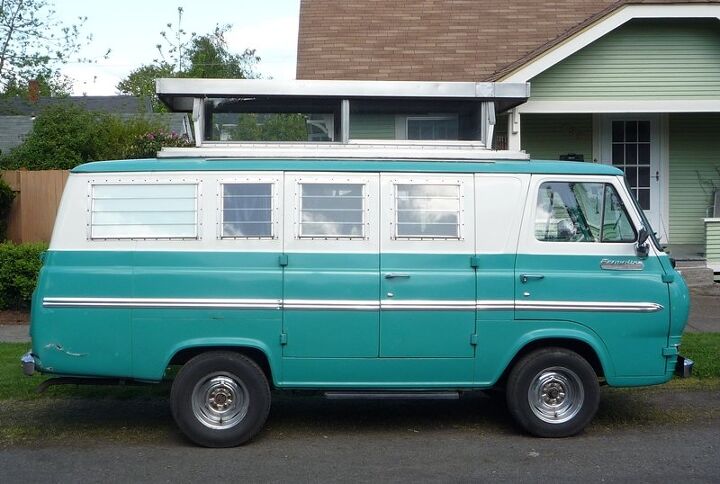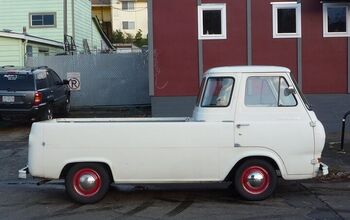Curbside Classic: 1965 Ford Econoline SuperVan Camper

This Econoline caught my eye for a number of reasons. These old bread boxes are getting scarce, even in Eugene. And this is one of the extended-body SuperVans, no less. But that’s not all; it has a trick in its hat. Watch this:
Yes, pop top campers are no big thing, but I hadn’t encountered one like this in a long while. No canvas here: the sides are rigid frames with windows all around. The clerestory camper. Being tall, and having memories of crawling around in the back of my ’68 Dodge A100 van makes this a very attractive proposition indeed.
The original Econoline appeared in 1960, in response to the growing popularity of the VW bus. Just like the Falcon it was loosely based on, the gen1 Falcon Van/Econoline was a highly pragmatic approach to building a compact van, compared to Chevy’s more ambitious rear-engined Corvair van (Corvan/Greenbrier). A box, a solid beam front axle in front and back, a wheezy little six between the seats, and no front crumple zone: a winning combination that is still being built around the world, although with independent front suspension. A timeless formula.
Despite all the enthusiasm about downsizing in 1960, the original Econoline ended up a bit smaller than what some folks, especially tradesmen and fleet buyers had in mind to carry their pipes and two by fours. I’m not exactly sure of the year it appeared, but Ford just grafted on a chunk on the rear end, and Presto: the SuperVan was born. It was a lot more primitive than what the competition did: Chevy and Dodge made extended wheelbase versions of their boxes. Ford was looking for a quick fix, since their idea of where their van was headed in a couple of years was already pretty clear.
The front seat in these vans was a memorable piece of primitiveness, even for the times. Just hunks of steel welded and screwed together. The padded dash on this one is a minor concession to safety that appeared on the later models. And the motor box made a handy third seat, nice and toasty in the winter.
The “regular” Econolines had the little Ford six, either the 144 or 170 cubic inch variety. They were both short on grunt, the 144 particularly so. But around the same time the SuperVan appeared (1965?) Ford also offered a “HeavyDuty” version, with the now venerable, but then brand new 240 CID “Big Six”, along with bigger 14″ wheels (instead of 13 inchers) and heavier springs.
I have vivid memories of riding in a HD Supervan, as a paperboy in Towson in 1965-1966. Our distributor drove one, and I’d hop in the back with stacks and stacks of Afternoon Sun papers. Old Econolines always evoke the smell of newsprint, and memories of ink-blackened hands.
I have to assume that the “long tail” Econolines probably had better traction, given the extra weight out back. The regular versions were notorious in the winter, with all that weight up front.
Getting enthusiastic about Econolines can be a bit challenging, but this one does it for me. If you’re an Econoline enthusiast, head here for the pickup version CC.

More by Paul Niedermeyer
Latest Car Reviews
Read moreLatest Product Reviews
Read moreRecent Comments
- Honda1 Unions were needed back in the early days, not needed know. There are plenty of rules and regulations and government agencies that keep companies in line. It's just a money grad and nothing more. Fain is a punk!
- 1995 SC If the necessary number of employees vote to unionize then yes, they should be unionized. That's how it works.
- Sobhuza Trooper That Dave Thomas fella sounds like the kind of twit who is oh-so-quick to tell us how easy and fun the bus is for any and all of your personal transportation needs. The time to get to and from the bus stop is never a concern. The time waiting for the bus is never a concern. The time waiting for a connection (if there is one) is never a concern. The weather is never a concern. Whatever you might be carrying or intend to purchase is never a concern. Nope, Boo Cars! Yeah Buses! Buses rule!Needless to say, these twits don't actual take the damn bus.
- MaintenanceCosts Nobody here seems to acknowledge that there are multiple use cases for cars.Some people spend all their time driving all over the country and need every mile and minute of time savings. ICE cars are better for them right now.Some people only drive locally and fly when they travel. For them, there's probably a range number that works, and they don't really need more. For the uses for which we use our EV, that would be around 150 miles. The other thing about a low range requirement is it can make 120V charging viable. If you don't drive more than an average of about 40 miles/day, you can probably get enough electrons through a wall outlet. We spent over two years charging our Bolt only through 120V, while our house was getting rebuilt, and never had an issue.Those are extremes. There are all sorts of use cases in between, which probably represent the majority of drivers. For some users, what's needed is more range. But I think for most users, what's needed is better charging. Retrofit apartment garages like Tim's with 240V outlets at every spot. Install more L3 chargers in supermarket parking lots and alongside gas stations. Make chargers that work like Tesla Superchargers as ubiquitous as gas stations, and EV charging will not be an issue for most users.
- MaintenanceCosts I don't have an opinion on whether any one plant unionizing is the right answer, but the employees sure need to have the right to organize. Unions or the credible threat of unionization are the only thing, history has proven, that can keep employers honest. Without it, we've seen over and over, the employers have complete power over the workers and feel free to exploit the workers however they see fit. (And don't tell me "oh, the workers can just leave" - in an oligopolistic industry, working conditions quickly converge, and there's not another employer right around the corner.)






































Comments
Join the conversation
Interesting vehicles these. There was a reddish orange pickup version in my old neighbourhood. Sat for years and the guy put it up for sale when he decided to move to a condo. I remember inquiring about the price and he wanted a ridiculous sum for what it was and the shape it was in. It eventually disappeared...he either landed a sucker or someone really loved it. Can a Divco cc be far behind? I always thought they were very interesting vehicles.
I had a '65 Supervan that started as a school bus in the B.C. interior. Windows all around. It had loading doors (factory) on both sides. The engine had been swapped out for a 300cid inline from a '73 5 ton. With that awesome 3 speed auto that could be started from a stop in 2nd gear, and heavy lug mud/snows on the back it was like a little jeep off-road. Got it in '79 for, I think, $150. A bed, and wood stove made from the hood of a '69 GMC pick-up. Great fun camping in the mountains! Sold it in Ontario in '89 for $2800.